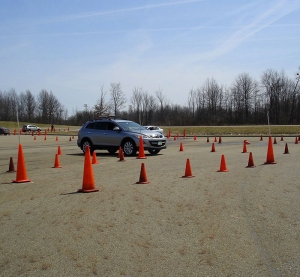 Whether you’re a seasoned driver with years of experience or your license is still shiny and new in your wallet, you can stay safer on the roads by learning how to drive defensively. Defensive driving doesn’t mean driving slowly and letting everyone else on the road pass you by. It’s a way to prevent accidents by being aware of what’s going on around you, and driving with knowledge and attentiveness to keep yourself and others safe.
Whether you’re a seasoned driver with years of experience or your license is still shiny and new in your wallet, you can stay safer on the roads by learning how to drive defensively. Defensive driving doesn’t mean driving slowly and letting everyone else on the road pass you by. It’s a way to prevent accidents by being aware of what’s going on around you, and driving with knowledge and attentiveness to keep yourself and others safe.
5 Tips for Defensive Driving
The best tips for defensive driving include:
- Avoid distractions. Probably the most important thing to remember when you’re driving is to focus on being safe when you’re behind the wheel. This means putting down the cell phone, choosing when to change the radio station, and waiting to eat the food you just picked up until you get home. Distracted driving is the number one cause of auto crashes today. Each day in the United States, more than 9 people are killed and more than 1,153 people are injured in crashes that are reported to involve a distracted driver, according to the Centers for Disease Control and Prevention. Remember that your most important priority when you’re in the car is to simply just drive.
- Be aware of other drivers. While you may be practicing safe driving techniques, that doesn’t mean that everyone else around you is. Watch out for those who may be swerving, talking or texting on the cell phone, nodding off, or just being reckless in general. Allow a minimum of three seconds in front of you and give space to at least one side of your vehicle as well.
- Avoid packs. We’ve all seen them, many cars bottlenecked together. When we drive, we’re within feet of many vehicles traveling at high speeds. Just one mistake can cause a massive pile up. As a defensive driver, either stay far enough back or get out ahead of the pack. This will give you time to react if a problem does occur, and it makes for a less stressful commute. Many accidents, especially in packs, are caused by suddenly changing lanes, so choose a lane and try to stay in it to avoid getting rear-ended. Watch for others constantly switching lanes, too. Many drivers will try to slip in and out of lanes even when it’s not safe to do so.
- Watch your blind spot. Pay attention to your own blind spot. You should be checking your mirrors every five to seven seconds, especially when you do need to switch lanes. Likewise, try to avoid being in other drivers’ blind spots; some drivers forget to check their blind spot before they move from lane to lane. Take a quick look at their side mirror, for eye contact, and front tire before you decide to pass.
- No tailgating. Driving too closely increases the risk for an accident, because you have very little time to react to sudden changes. It takes the average driver a minimum of two seconds to identify and decide to react to a problem, and then you still have to implement that reaction.
It’s recommended to keep at least a three second cushion between your car and the one in front of you – more if the weather conditions are bad.
Drive Team offers training programs for those of all ages. Our Corporate Driver Training Programs will give your employees the hands-on experience they need to become safe, confident drivers, while our Teen Driving Programs will teach those new to the road the skills they need to be safe drivers for life. Contact us for more information.